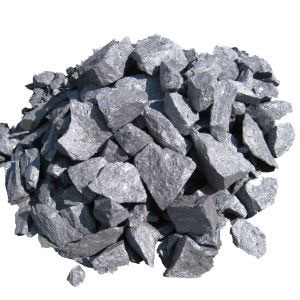
The use of Rare Earth Ferro Silicon Magnesium for Cast Iron is a good way to increase the strength of ductile iron and prevent premature failure. The spheroidal graphite nodules produced by this alloy are evenly distributed throughout the iron making for a stronger and more ductile cast iron.
Several varieties of Rare Earth Ferro Silicon Magnesium are available at Hickman, Williams & Company for use in treating molten iron. These range from 3 to 4 percent magnesium for minimal reactivity and high magnesium recovery, to 5 to 6 percent magnesium for normal practice.
These alloys have an excellent nodulizing ability, a very high magnesium recovery rate and can be used in a wide variety of methods of spheroidizing molten iron to produce ductile and compacted graphite cast irons. The magnesium content of these alloys can be adjusted by the customer to meet their specific requirements.
Spheroidization of ductile and compacted graphite castings is dependent on the availability of certain chemical elements in the molten iron to produce the desired microstructure of the iron. These elements are:
The most important spheroidizing element is magnesium and this is the primary component in FeSiMg alloys. The amount of magnesium in the alloy can be controlled by choice of treatment method, degree of reactivity, economy of addition rate and size of mold.
Calcium is an essential element for controlling the reaction of magnesium with molten iron in order to produce the required microstructure of ductile and compacted graphite. However, too much calcium may inhibit dissolution of the magnesium reagent and produce slag which is undesirable in a ductile or compacted graphite cast iron.

This can be controlled by controlling the calcium content in the nodulizer or by selecting an alloy with a low level of calcium in it. This control will improve the nodulation of molten iron, reduce slag formation and eliminate worm-shaped graphite which can be undesirable in ductile and compacted graphite.
A low level of calcium also retards the melting point of the alloy and thereby improves its dissolution rate. This is desirable in a number of cases because it will result in less heat loss and a faster melt and a higher recovery of magnesium.
Other essential components of these alloys are:
A proper balance of REs provides superior microstructure, improved mechanical properties and a reduced risk of carbide and shrink defects. A proper balance of REs is also necessary in order to provide protection against deleterious impurities sometimes found in molten iron such as S, O2, Bi, Pb and Sb which can be detrimental to the microstructure and mechanical properties of a casting.
The presence of REs can also prevent the production of hard iron carbides in thin sections of a casting that cool first.
These alloys are suitable for a wide variety of casting processes including pour-over, sandwich, tundish, pocket and in-mold. They are also useful for treating a wide variety of materials such as pig iron, steel scrap and aluminum castings.

Write a Message